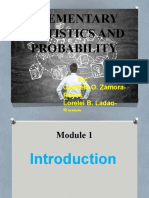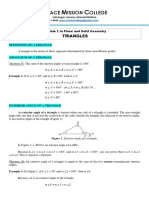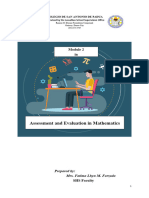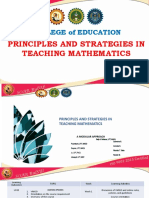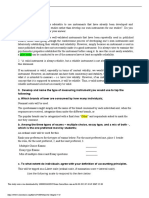Module in Elementary Statistics and Probability With Laboratory
Uploaded by
Monec JalandoniModule in Elementary Statistics and Probability With Laboratory
Uploaded by
Monec JalandoniMATH 106A: ELEMENTARY STATISTICS AND PROBABILITY (WITH LABORATORY)
Module in
ELEMENTARY
STATISTICS AND
PROBABILITY
(WITH LABORATORY)
Prepared by:
Jenny N. Sedano
Faculty, Mathematics Department
ISAT U MIAGAO CAMPUS 1
MATH 106A: ELEMENTARY STATISTICS AND PROBABILITY (WITH LABORATORY)
Module 1
Basic Concepts about Statistics
CHAPTER I Introduction to Statistics
Definition of Statistics
In its plural sense, statistics is a set of numerical data (e.g., vital statistics in a
beauty contest, monthly sales of a company, daily P-$ exchange rate).
In its singular sense, Statistics is that branch of science which deals with the
collection, presentation, analysis, and interpretation of data.
Types of Statistics
Descriptive Statistics - methods concerned with the collection, description, and
analysis of a set of data without drawing conclusions or inferences about a larger
set; the main concern is simply to describe the set of data such that otherwise
obscure information is brought out clearly conclusions apply only to the data on
hand
Inferential Statistics - methods concerned with making predictions or inferences
about a larger set of data using only the information gathered from a subset of
this larger set; the main concern is not merely to describe but actually predict
and make inferences based on the information gathered; conclusions are
applicable to a larger set of data which the data on hand is only a subset
Descriptive Statistics vs. Inferential Statistics
Descriptive Inferential
A bowler wants to find his bowling A bowler wants to estimate his chance
average for the past 12 games. of winning a game based on his
current season averages and the
averages of his opponents.
A housewife wants to determine the A housewife would like to predict
average weekly amount she spent based on last year’s grocery bills, the
on groceries in the past 3 months. average weekly amount she will spend
on groceries for this year.
A politician wants to know the exact A politician would like to estimate,
number of votes he received in the based on an opinion poll, his chance
last election. for winning in the upcoming election.
Exercises: Determine whether the following statements use the area of descriptive
statistics or inferential statistics.
1. A manager would like to predict based on previous years’ sales, the sales
performance of a company for the next five years.
2. If the present trend continues, architects will construct more contemporary
homes than colonials in the next five years.
ISAT U MIAGAO CAMPUS 2
MATH 106A: ELEMENTARY STATISTICS AND PROBABILITY (WITH LABORATORY)
3. A teacher wishes to determine the percentage of students who passed the
examination.
4. A basketball player wants to estimate his chance of winning the most valuable
player (MVP) award based on his current season average and the averages of
the opponents.
Uses of Statistics
In the biological and medical sciences, it can help researchers discover
relationships worthy of further attention.
Example: A doctor can use Statistics to determine to what extent is an increase in
blood pressure dependent upon age.
In the social sciences, it can guide and help researchers support theories and
models that cannot stand on rationale alone.
Example: Empirical studies are using Statistics to obtain socio-economic profile of
the middle class to form new socio-political theories on classes as the existing
theories apparently are no longer valid.
In business, a company can use statistics to forecast sales, design products, and
produce goods more efficiently.
Example: A pharmaceutical company can apply statistical procedures to find out if a
new formula is indeed more effective than the one being used. Results can help the
company decide whether to market the new formula or not.
In engineering, it can be used to test properties of various materials.
Example: A quality controller can use Statistics to estimate the average lifetime of
the products produced by their current equipment.
In education, statistics can be used to assess students’ performance and
correlate factors affecting teaching and learning process to improve quality
education.
Example: A teacher can correlate the factors affecting the academic performance of
the students in Elementary Statistics subject.
In psychology, statistics is used to determine attitudinal patterns, the causes and
effects of misbehavior.
In research, statistics is used to validate or test a claim or inferences about a
group of people, objects or series of events.
Population and Sample
Definition.
ISAT U MIAGAO CAMPUS 3
MATH 106A: ELEMENTARY STATISTICS AND PROBABILITY (WITH LABORATORY)
A population is a collection of all the elements under consideration in a statistical
study.
A sample is a part or subset of the population from which the information is
collected.
Example: A manufacturer of kerosene heaters wants to determine if customers are
satisfied with the performance of their heaters. Toward this goal, 5,000 of his 200,000
customers are contacted and each is asked, “Are you satisfied with the performance of
the kerosene heater you purchased?” Identify the population and the sample for this
situation.
Definition.
A parameter is a numerical characteristic of the population.
A statistic is a numerical characteristic of the sample.
Example: In order to estimate the true proportion of students at a certain college
who smoke cigarettes, the administration polled a sample of 200 students and
determined that the proportion of students from the sample who smoke cigarettes is
0.12. Identify the parameter and the statistic.
CHAPTER II Data Collection
Steps in a Statistical Inquiry
1. Define the problem.
2. Formulate the research design.
3. Collect the data.
4. Code and analyze the collected data.
5. Interpret the results.
Variables and Measurement
Definition. A variable is a characteristic or attribute of persons or objects which can
assume different values or labels for different persons or objects under consideration.
Definition. Measurement is the process of determining the value or label of a
particular variable for a particular experimental unit.
Definition. An experimental unit is the individual or object on which a variable is
measured.
Classification of Variables
1. Discrete vs Continuous
Discrete variable – refers to variables that can be obtained through counting or
enumerating.
ISAT U MIAGAO CAMPUS 4
MATH 106A: ELEMENTARY STATISTICS AND PROBABILITY (WITH LABORATORY)
Examples: number of students, number of books, and number of patients
Continuous variable - a variable which can assume infinitely many values
corresponding to a line interval
Examples: height, weight and temperature
2. Qualitative vs Quantitative
Qualitative variable - a variable that yields categorical responses
Examples: religious affiliation, occupation, marital status
Quantitative variable - a variable that takes on numerical values representing an
amount or quantity
Examples: weight, height, and number of cars
Levels of Measurement
1. Nominal Level (or Classificatory Scale)
The nominal level is the weakest level of measurement where numbers or
symbols are used simply for categorizing subjects into different groups.
Examples:
Sex M-Male F-Female
Marital status 1-Single 2-Married 3-Widowed 4-Separated
2. Ordinal Level (or Ranking Scale)
The ordinal level of measurement contains the properties of the nominal level,
and in addition, the numbers assigned to categories of any variable may be ranked or
ordered in some low-to-high-manner.
Examples:
Teaching ratings
1-poor 2- fair 3-good 4-excellent
Year level
1-1st yr 2 – 2nd yr
3 – 3rd yr 4 – 4th yr
3. Interval Level
The interval level is that which has the properties of the nominal and ordinal
levels, and in addition, the distances between any two numbers on the scale are of
known sizes. An interval scale must have a common and constant unit of measurement.
Furthermore, the unit of measurement is arbitrary and there is no “true zero” point.
Examples:
Intellectual Quotient (IQ)
ISAT U MIAGAO CAMPUS 5
MATH 106A: ELEMENTARY STATISTICS AND PROBABILITY (WITH LABORATORY)
Temperature (in Celsius)
4. Ratio Level
The ratio level of measurement contains all the properties of the interval level,
and in addition, it has a “true zero” point.
Examples:
Age (in years)
Number of correct answers in an exam
Classification of Data
1. Primary vs. Secondary
Primary source - data measured by the researcher/agency that published it
Secondary source - any republication of data by another agency
Example: The publications of the National Statistics Office are primary sources and all
subsequent publications of other agencies are secondary sources.
2. External vs. Internal
Internal data - information that relates to the operations and functions of the
organization collecting the data
External data - information that relates to some activity outside the organization
collecting the data
Example: The sales data of SM is internal data for SM but external data for any
other organization such as Robinson’s.
Data Collection Methods
Survey method - questions are asked to obtain information, either through self-
administered questionnaire or personal interview
Self-administered questionnaire Personal interview
Obtained information is limited to Missing information and vague
subjects’ written answers to pre- responses are minimized with the
arranged questions proper probing of the interviewer
Lower response rate Higher response rate through call-
backs
It can be administered to a large It is administered to a person or
number of people simultaneously group one at a time
ISAT U MIAGAO CAMPUS 6
MATH 106A: ELEMENTARY STATISTICS AND PROBABILITY (WITH LABORATORY)
Respondents may feel freer to express Respondent may feel more cautious
views and are less pressured to particularly in answering sensitive
answer immediately questions for fear of disapproval
It is more appropriate for obtaining It is more appropriate for obtaining
objective information about complex emotionally-laden
topics or probing sentiments
underlying an expressed opinion
Observation method - makes possible the recording of behavior but only at the
time of occurrence (e.g., observing reactions to a particular stimulus, traffic
count)
Advantages over Survey Method:
- does not rely on the respondent’s willingness to provide information
- certain types of data can be collected only by observation (e.g. behavior patterns
of which the subject is not aware of or is ashamed to admit)
- the potential bias caused by the interviewing process is reduced or eliminated
Disadvantages over Survey Method:
- things such as awareness, beliefs, feelings and preferences cannot be observed
- the observed behavior patterns can be rare or too unpredictable thus increasing
the data collection costs and time requirements
Experimental method - a method designed for collecting data under controlled
conditions. An experiment is an operation where there is actual human
interference with the conditions that can affect the variable under study. This is
an excellent method of collecting data for causation studies. If properly
designed and executed, experiments will reveal with a good deal of accuracy, the
effect of a change in one variable on another variable.
Use of existing studies - e.g., census, health statistics, and weather bureau
reports
Two types:
- documentary sources - published or written reports, periodicals, unpublished
documents, etc.
-
- field sources – researchers who have done studies on the area of interest are
asked personally or directly for information needed
Registration method - e.g., car registration, student registration, and hospital
admission
ISAT U MIAGAO CAMPUS 7
MATH 106A: ELEMENTARY STATISTICS AND PROBABILITY (WITH LABORATORY)
General Classification of Collecting Data
Definition. Census or complete enumeration is the process of gathering information
from every unit in the population.
- not always possible to get timely, accurate and economical data
- costly, especially if the number of units in the population is too large
Definition. Survey sampling is the process of obtaining information from the units in
the selected sample.
Advantages of Survey Sampling:
• reduced cost
• greater speed
• greater scope
• greater accuracy
ISAT U MIAGAO CAMPUS 8
MATH 106A: ELEMENTARY STATISTICS AND PROBABILITY (WITH LABORATORY)
Name: _______________________________________________
Year & Section: ________________________________________
Date Submitted: _______________________________________
Score: _______________
PERFORMANCE TASK (LECTURE)
Exercise 1.1
Classify the following statements as belonging to the area of descriptive
statistics or statistical inference. Write DS for descriptive statistics and write
IS for inferential statistics on the space provided.
______1. Yesterday's records show that five (5) employees were absent due to Dengue
fever.
______2. If the present trend continues, architects will construct more contemporary
homes than colonials in the next 5 years.
______3. In a certain city, arsonists deliberately set 3% of all fires reported last year.
______4. At least 30% of all new homes being built today are of a contemporary design.
______5. As a result of a recent poll, most Filipinos are in favor of finding work
employment abroad.
______6. Philippines' Gross Domestic Product (GDP) grows by 4.6% in 2002, 1.4
percentage points higher than its 3.2% performance in 2001.
______7. The average grade of 10 students in English is 89.46%.
______8. Based from the present sales trend, it is expected that after two years, this
year's sales will be doubled.
______9. All four provinces of ARMM are among the 10 poorest provinces in the
Philippines for 2002.
______10. During the period 1996 to 2002, unemployment rates among women were
consistently higher compared to men except in 1999 and 2000.
ISAT U MIAGAO CAMPUS 9
MATH 106A: ELEMENTARY STATISTICS AND PROBABILITY (WITH LABORATORY)
Exercise 1.2
A. Identify the population, variable of interest, and type of variable in the
following:
1. The dean of a certain college would like to determine the average weekly allowance
of BS Computer Science students.
Population: ________________________________________________________
Variable: ________________________________________________________
Type of Variable: ________________________________________________________
2. The DLSU-D Admissions Office would like to conduct a survey on the preferred
courses of 4th year high school students in Cavite.
Population: ________________________________________________________
Variable: ________________________________________________________
Type of Variable: ________________________________________________________
3. The dean of the College of Science would like to know the number of students who
are smoking.
Population: ________________________________________________________
Variable: ________________________________________________________
Type of Variable: ________________________________________________________
4. A survey by a group of students entitled “Dress Code” will be conducted to first year
students to determine the fashion preferences of these students.
Population: ________________________________________________________
Variable: ________________________________________________________
Type of Variable: ________________________________________________________
5. Information will be collected to new voters for 2004 election to identify their opinion
regarding politics in the Philippines.
Population: ________________________________________________________
Variable: ________________________________________________________
ISAT U MIAGAO CAMPUS 10
MATH 106A: ELEMENTARY STATISTICS AND PROBABILITY (WITH LABORATORY)
Type of Variable: ________________________________________________________
6. From all students registered this semester, the Mathematics Department would like to
know how many students like mathematics.
Population: ________________________________________________________
Variable: ________________________________________________________
Type of Variable: ________________________________________________________
7. A study to be conducted by an NGO would determine the Filipinos' awareness about
the war against IRAQ.
Population: ________________________________________________________
Variable: ________________________________________________________
Type of Variable: ________________________________________________________
8. A group of students taking Statistics conducted a study on the effect of boy-girl
relationship to the academic performance of the students.
Population:
Variable:
Type of Variable:
9. Some parents would like to determine whether Counter Strike is good or bad to the
behavior of their children.
Population: ________________________________________________________
Variable: ________________________________________________________
Type of Variable: ________________________________________________________
10.The head librarian would like to identify the book/s commonly read by DLSU-D
students.
Population: ________________________________________________________
Variable: ________________________________________________________
Type of Variable: ________________________________________________________:
11. A statistics teacher, Mrs. Reyes, would like to determine whether the number of
students in a class at the start of the semester can determine the number of failures.
ISAT U MIAGAO CAMPUS 11
MATH 106A: ELEMENTARY STATISTICS AND PROBABILITY (WITH LABORATORY)
Population: ________________________________________________________
Variable: ________________________________________________________
Type of Variable: ________________________________________________________
B. Identify each statement as having discrete or continuous data. Write D for
discrete and C for continuous on the space provided.
_____1. Among 1,500,000 microcomputer chips made by Motocolla,2 are found to be
defective.
_____2. Yesterday's records show that 25 students were absent.
_____3. Radar on EDSA indicated that the driver was going 150 kph when ticketed for
speeding
_____4. The amount of time that a taxi driver spends yielding to individual pedestrians
each year is 2.367 seconds.
_____5. Upon completion of a diet and exercise program, Tony weighed 12.37 lbs. less
than when he started the program.
C. Identify which of the following quantitative data would be represented by a
discrete variable or a continuous variable. Write DV for discrete variable and
write CV for continuous variable.
_____1. number of students
_____2. time (in minutes) to finish an exam
_____3. distance ( in km.) of school from place of residence
_____4. length ( in cm.) of fish caught
_____5. width of the newest brand of cellular phone
ISAT U MIAGAO CAMPUS 12
MATH 106A: ELEMENTARY STATISTICS AND PROBABILITY (WITH LABORATORY)
_____6. percentage increase in enrolment this year
_____7. number of enrollees
_____8. monthly income of 100 randomly selected persons at KADIWA Market
_____9. sum of points in tossing a pair of dice
_____10. lifetime(in years) of televisions produced by ZONY
Exercise 1.3
A. At what level are the following variables measured? Write nominal, ordinal,
interval or ratio on the space provided.
________________1. student number
________________2. weights of a sample of candies
________________3. zip codes
________________4. SSS number
________________5.final course grades of 4.0,3.75,3.5.....
________________6. instructors rated as superior, above average, average, below
average, or poor
________________7. movies listed according to their genre such as comedy, adventure,
romance, action, suspense, or horror
________________8. lengths of TV commercials (in
seconds)
________________9. distances ( in km) traveled by a bus
________________10. the years 1896,2000,1776,1995
________________11.Attitude toward gun laws such as very favorable, somewhat
favorable, somewhat unfavorable...
ISAT U MIAGAO CAMPUS 13
MATH 106A: ELEMENTARY STATISTICS AND PROBABILITY (WITH LABORATORY)
________________12.Ideal number of children
________________13.Family Income(in peso)
________________14.Candidate voted for in 2002 barangay elections
________________15.tax identification number(TIN)
________________16.gender
________________17. average number of glasses of water consumed per day
________________18. blood pressure
________________19.height of students
________________20.number of clients
________________21.number of won cases in court
________________22. academic rank in high school
________________23. Savings Account Number
________________24. Are you a Pag-ibig Member?(Yes/No)
________________25. number of books sold per day
________________26.weekly allowance of a DLSU-D student
________________27.main source of income
________________28.birth order of children in the family
________________29.number of organizations involved in
________________30.car plate number
ISAT U MIAGAO CAMPUS 14
MATH 106A: ELEMENTARY STATISTICS AND PROBABILITY (WITH LABORATORY)
Exercise 1.4
My Reflection in this Lesson
Write a paragraph regarding your reflection about this lesson.
Guide questions:
What topics do you like most in our lesson?
What topics are difficult to understand?
What have you learned and experienced while answering your activity?
_______________________________________________________________________
END
I affirm that I have not copied the work of others in answering my performance task and this work is my own.
_____________________________
Student’s Name and Signature
ISAT U MIAGAO CAMPUS 15
You might also like
- Principles and Strategies in Teaching Mathematics100% (4)Principles and Strategies in Teaching Mathematics12 pages
- Number Theory Course Syllabus S.Y 2022-2023100% (1)Number Theory Course Syllabus S.Y 2022-202310 pages
- Richard C. Rich, Craig Leonard Brians, Jarol B. Manheim, Lars Willnat - Empirical Political Analysis - Quantitative and Qualitative Research Methods (2018, Routledge)No ratings yetRichard C. Rich, Craig Leonard Brians, Jarol B. Manheim, Lars Willnat - Empirical Political Analysis - Quantitative and Qualitative Research Methods (2018, Routledge)398 pages
- Elementary Statistics and Probability: By: Carmela O. Zamora-Reyes Lorelei B. Ladao - Saren100% (2)Elementary Statistics and Probability: By: Carmela O. Zamora-Reyes Lorelei B. Ladao - Saren27 pages
- SYLLABUS (Elementary Statistics and Probability)50% (2)SYLLABUS (Elementary Statistics and Probability)2 pages
- Authentic Assessment Methods in Mathematics Education100% (2)Authentic Assessment Methods in Mathematics Education37 pages
- Module 2 - Assessment and Evaluation in MathematicsNo ratings yetModule 2 - Assessment and Evaluation in Mathematics18 pages
- MATH 69: Assessment and Evaluation in MathematicsNo ratings yetMATH 69: Assessment and Evaluation in Mathematics29 pages
- Syllabus Math Ed 15 Principles and Methods of Teaching100% (1)Syllabus Math Ed 15 Principles and Methods of Teaching9 pages
- Principles and Strategies in Teaching Math For StudentsNo ratings yetPrinciples and Strategies in Teaching Math For Students78 pages
- Assessment and Evaluation in Teahcing Math Midterm ExamNo ratings yetAssessment and Evaluation in Teahcing Math Midterm Exam10 pages
- Chapter 1 Description and History of Statistical ScienceNo ratings yetChapter 1 Description and History of Statistical Science2 pages
- Module 5 Neutral Geometry Projective Geometry and Differential GeometryNo ratings yetModule 5 Neutral Geometry Projective Geometry and Differential Geometry12 pages
- Im Module 5 Finite Geometries of Fano and Young Pappus and DesarguesNo ratings yetIm Module 5 Finite Geometries of Fano and Young Pappus and Desargues38 pages
- Ed Math 6 Calculus 1 With Analytic Geometry100% (1)Ed Math 6 Calculus 1 With Analytic Geometry2 pages
- Group 2 - Axioms of Betweeness (Bsed - Math 2) - Math 10No ratings yetGroup 2 - Axioms of Betweeness (Bsed - Math 2) - Math 1019 pages
- Module I CONCEPTUAL FRAMEWORK OF MATHEMATICS EDUCATION COMPRA SUTCHEZA DAMAYO BSED3 ANo ratings yetModule I CONCEPTUAL FRAMEWORK OF MATHEMATICS EDUCATION COMPRA SUTCHEZA DAMAYO BSED3 A43 pages
- Principles Strategies in Teaching MathematicsNo ratings yetPrinciples Strategies in Teaching Mathematics92 pages
- Syllabus Calculus 1 With Analytic GeometryNo ratings yetSyllabus Calculus 1 With Analytic Geometry4 pages
- Problem Solving, Mathematical Investigation and Modeling Week 2 Strategies For Solving Problems100% (1)Problem Solving, Mathematical Investigation and Modeling Week 2 Strategies For Solving Problems5 pages
- Principles and Strategies in Teaching Mathematics ReportNo ratings yetPrinciples and Strategies in Teaching Mathematics Report29 pages
- Elementary Stat Course Syllabus S.Y 2020-2021No ratings yetElementary Stat Course Syllabus S.Y 2020-202113 pages
- Performance Standards, Competencies, and Learning Targets in MathematicsNo ratings yetPerformance Standards, Competencies, and Learning Targets in Mathematics39 pages
- Finite Geometry of Young - Managat.leizelNo ratings yetFinite Geometry of Young - Managat.leizel28 pages
- Articulating K To 12 Competencies in Mathematics Learning With Success IndicatorsNo ratings yetArticulating K To 12 Competencies in Mathematics Learning With Success Indicators16 pages
- MODULE in Assessment and Evaluation in Mathematics EducationNo ratings yetMODULE in Assessment and Evaluation in Mathematics Education33 pages
- Lesson 1 Conceptual Framework of Mathematics From K 3100% (2)Lesson 1 Conceptual Framework of Mathematics From K 334 pages
- Cobe Syllabus. Math Ed 7 (Calculus 1 With Analytic Geometry)100% (1)Cobe Syllabus. Math Ed 7 (Calculus 1 With Analytic Geometry)14 pages
- Module Assessment in Learning 2 (Simplified Version)100% (1)Module Assessment in Learning 2 (Simplified Version)110 pages
- Slides Prepared by John S. Loucks St. Edward's University: 1 Slide © 2003 Thomson/South-WesternNo ratings yetSlides Prepared by John S. Loucks St. Edward's University: 1 Slide © 2003 Thomson/South-Western34 pages
- Learning Area Grade Level Quarter Date I. Lesson Title Ii. Most Essential Learning Competencies (Melcs) Iii. Content/Core ContentNo ratings yetLearning Area Grade Level Quarter Date I. Lesson Title Ii. Most Essential Learning Competencies (Melcs) Iii. Content/Core Content4 pages
- Classification, Collection & Presentation of Data100% (2)Classification, Collection & Presentation of Data6 pages
- Measurement and Scale Construction TechniquesNo ratings yetMeasurement and Scale Construction Techniques61 pages
- Use The Following Scale To Respond To The Item BelowNo ratings yetUse The Following Scale To Respond To The Item Below3 pages
- STA301 CurrentPastFinalTermSolvedQuestionsNo ratings yetSTA301 CurrentPastFinalTermSolvedQuestions152 pages
- Guía de Probabilidad y Estadística Etapa 1No ratings yetGuía de Probabilidad y Estadística Etapa 15 pages
- Get Numerical Analysis for Engineers Methods and Applications Second Edition Bilal Ayyub (Author) PDF ebook with Full Chapters Now100% (9)Get Numerical Analysis for Engineers Methods and Applications Second Edition Bilal Ayyub (Author) PDF ebook with Full Chapters Now82 pages
- Test Bank for Psychological Testing Principles, Applications, and Issues, 8th Edition - PDF Version Is Available For Instant Access100% (8)Test Bank for Psychological Testing Principles, Applications, and Issues, 8th Edition - PDF Version Is Available For Instant Access52 pages
- Descriptive Statistics Tutorial 1 SolutionsNo ratings yetDescriptive Statistics Tutorial 1 Solutions5 pages
- Richard C. Rich, Craig Leonard Brians, Jarol B. Manheim, Lars Willnat - Empirical Political Analysis - Quantitative and Qualitative Research Methods (2018, Routledge)Richard C. Rich, Craig Leonard Brians, Jarol B. Manheim, Lars Willnat - Empirical Political Analysis - Quantitative and Qualitative Research Methods (2018, Routledge)
- Elementary Statistics and Probability: By: Carmela O. Zamora-Reyes Lorelei B. Ladao - SarenElementary Statistics and Probability: By: Carmela O. Zamora-Reyes Lorelei B. Ladao - Saren
- Authentic Assessment Methods in Mathematics EducationAuthentic Assessment Methods in Mathematics Education
- Module 2 - Assessment and Evaluation in MathematicsModule 2 - Assessment and Evaluation in Mathematics
- Syllabus Math Ed 15 Principles and Methods of TeachingSyllabus Math Ed 15 Principles and Methods of Teaching
- Principles and Strategies in Teaching Math For StudentsPrinciples and Strategies in Teaching Math For Students
- Assessment and Evaluation in Teahcing Math Midterm ExamAssessment and Evaluation in Teahcing Math Midterm Exam
- Chapter 1 Description and History of Statistical ScienceChapter 1 Description and History of Statistical Science
- Module 5 Neutral Geometry Projective Geometry and Differential GeometryModule 5 Neutral Geometry Projective Geometry and Differential Geometry
- Im Module 5 Finite Geometries of Fano and Young Pappus and DesarguesIm Module 5 Finite Geometries of Fano and Young Pappus and Desargues
- Group 2 - Axioms of Betweeness (Bsed - Math 2) - Math 10Group 2 - Axioms of Betweeness (Bsed - Math 2) - Math 10
- Module I CONCEPTUAL FRAMEWORK OF MATHEMATICS EDUCATION COMPRA SUTCHEZA DAMAYO BSED3 AModule I CONCEPTUAL FRAMEWORK OF MATHEMATICS EDUCATION COMPRA SUTCHEZA DAMAYO BSED3 A
- Problem Solving, Mathematical Investigation and Modeling Week 2 Strategies For Solving ProblemsProblem Solving, Mathematical Investigation and Modeling Week 2 Strategies For Solving Problems
- Principles and Strategies in Teaching Mathematics ReportPrinciples and Strategies in Teaching Mathematics Report
- Performance Standards, Competencies, and Learning Targets in MathematicsPerformance Standards, Competencies, and Learning Targets in Mathematics
- Articulating K To 12 Competencies in Mathematics Learning With Success IndicatorsArticulating K To 12 Competencies in Mathematics Learning With Success Indicators
- MODULE in Assessment and Evaluation in Mathematics EducationMODULE in Assessment and Evaluation in Mathematics Education
- Lesson 1 Conceptual Framework of Mathematics From K 3Lesson 1 Conceptual Framework of Mathematics From K 3
- Cobe Syllabus. Math Ed 7 (Calculus 1 With Analytic Geometry)Cobe Syllabus. Math Ed 7 (Calculus 1 With Analytic Geometry)
- Module Assessment in Learning 2 (Simplified Version)Module Assessment in Learning 2 (Simplified Version)
- Slides Prepared by John S. Loucks St. Edward's University: 1 Slide © 2003 Thomson/South-WesternSlides Prepared by John S. Loucks St. Edward's University: 1 Slide © 2003 Thomson/South-Western
- Learning Area Grade Level Quarter Date I. Lesson Title Ii. Most Essential Learning Competencies (Melcs) Iii. Content/Core ContentLearning Area Grade Level Quarter Date I. Lesson Title Ii. Most Essential Learning Competencies (Melcs) Iii. Content/Core Content
- Use The Following Scale To Respond To The Item BelowUse The Following Scale To Respond To The Item Below
- Get Numerical Analysis for Engineers Methods and Applications Second Edition Bilal Ayyub (Author) PDF ebook with Full Chapters NowGet Numerical Analysis for Engineers Methods and Applications Second Edition Bilal Ayyub (Author) PDF ebook with Full Chapters Now
- Test Bank for Psychological Testing Principles, Applications, and Issues, 8th Edition - PDF Version Is Available For Instant AccessTest Bank for Psychological Testing Principles, Applications, and Issues, 8th Edition - PDF Version Is Available For Instant Access







